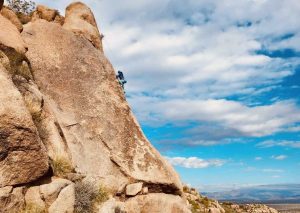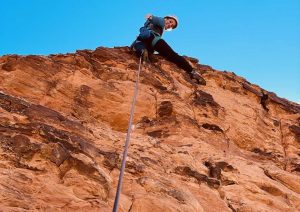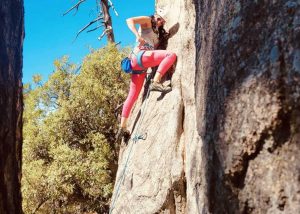- Slug: Sports-Rock Climbing Recovery, 900 words.
- 3 photos available.
By Jorden Hampton
Cronkite News
PHOENIX – Jillian Stannard lay in a hospital bed, her skin peeling off after battling Stevens-Johnson syndrome and fibromyalgia. She could barely eat, and her body rejected the medication prescribed by doctors to treat her illnesses.
“I was throwing up. I was shaking, I was vibrating,” Stannard recalled. “I couldn’t stop seeing the images. I couldn’t sleep through the night even with prescription medication.
“And that’s when they essentially told me, ‘There’s nothing else for us to try. You’re on every medication.’ And so I didn’t know what to do.”
Fibromyalgia, which causes pain and tenderness throughout the body, as well as fatigue and trouble sleeping, has no cure, according to the National Institute of Arthritis and Musculoskeletal and Skin Diseases. Stevens-Johnson syndrome is a rare but serious skin reaction that’s usually caused by taking certain medicines, according to the National Health Service.
Stannard, 44, was diagnosed with fibromyalgia in 2008 at 28 years old and Stevens-Johnson Syndrome at 29, but she had been dealing with anxiety and depression since 12. The doctor’s revelation turned her existing depression severe. With no solution inside the hospital, she turned to outside activities as a last-ditch effort to recover.
Initially, she took up hiking in the Arizona mountains and paddleboarding before finding the best medicine to cure her physical and mental health was rock climbing.
“I was pretty disabled for a couple of decades,” said Stannard, who moved from Rockaway, New Jersey to Arizona at 20 years old. “In 2020, I found alternative ways to heal and I was able to get off modern medicine. … In that process of healing, I realized how important nature is for us.”
Nature is a form of therapy for people struggling with mental health, and rock climbing is one of the avenues that can help, studies show. The outdoors serves as a venue to bond with friends and family and connect with the larger community, according to the U.S. Department of Agriculture. Participating in outdoor activities can help lower the risk of depression, increase stress recovery and increase focus and attention, according to the Axis Health System.
“Because it’s a physical activity, we’re working with endorphins,” said licensed therapist Robbin Cooley, who serves many clients who rock climb in the Phoenix area and Texas. “Physical activity is going to help with sleep, which helps regulate emotions and relieve stress.
“Typically depression, we’re stuck in the past with things that have happened. Mindfulness is required to rock climb and people have to be in the present. … There’s outdoor-based therapy, there’s nature therapy, there’s adventure therapy. You’re so present when you’re rock climbing, no matter if you’re indoors or outdoors.”
Stannard began indoor rock climbing at the Alta Rock Climbing gym in Gilbert in search of a challenge to help her mental state. She views the sport like a puzzle to solve.
“I got two free passes to a rock climbing gym and thought it was something fun to do,” Stannard said. “I went with one of my kids and really enjoyed it. I came back and got excited. I realized there was so much to learn with rock climbing.”
Sharing her experience with friends, Stannard felt temporary relief from her medical condition. Outdoor rock climbing, however, proved to be a different experience.
“I was scared to go outside,” said Stannard, who was reluctant when introduced to the activity by a friend. “(I thought) maybe one day when I’m really good, I’ll go outside.
“I climbed outside with my friend’s help. I realized the fear was in my mind – I can do this. It’s a constant process of overcoming fear. I love the sense of accomplishment I get after I do something that seems scary.”
After climbing outside for the first time in Mammoth, California, Stannard brought her shoes and harness back to Arizona. She also found a mentor who introduced her to new types of climbing, including sport climbing, face climbing, slab climbing and crack climbing. Those skills have helped her conquer Maiden Voyage in Sedona, Humphrey’s Peak, Ouray Via Ferrata in Colorado and The Flatiron in the Superstition Mountains.
“I would go rock climbing and freeze,” Stannard said. “My mentor would ask me if it was scary or if it was hard. I realized it was OK to fall, and it was good to do hard things.”
Since taking up climbing, Stannard has met a community of people who use rock climbing as a form of therapy and she doesn’t have to feel alone. One person who has been especially influential in helping her improve is Brandon Dubuc.
Dubuc teaches rock climbing to others battling mental health and uses rock climbing to overcome his own fears. He has seen the benefit of rock climbing as a form of therapy.
“Grounding and climbing can help people reduce stress and anxiety levels,” Dubuc said. “It also helps increase serotonin levels in the brain.”
Finding peace with rock climbing has helped Stannard overcome her health struggles and find a new purpose through her newfound outlet. From barely being able to climb out of bed due to illness to summiting the tallest peaks in the West, she has shown resilience and doesn’t plan to slow down.
“It feels amazing,” Stannard said. “I can take deep breaths and exhale. I feel most at peace when I am outdoors rock climbing. Sometimes I cry when I get to the top.”
For more stories from Cronkite News, visit cronkitenews.azpbs.org.


